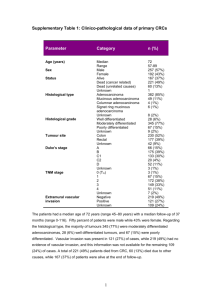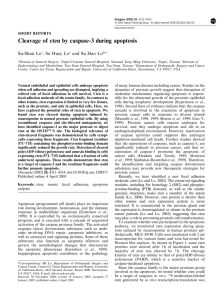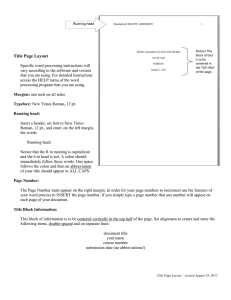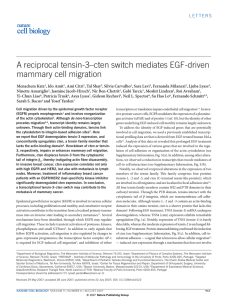Up-regulation of C-Terminal Tensin-like Molecule Promotes the B-Catenin
advertisement
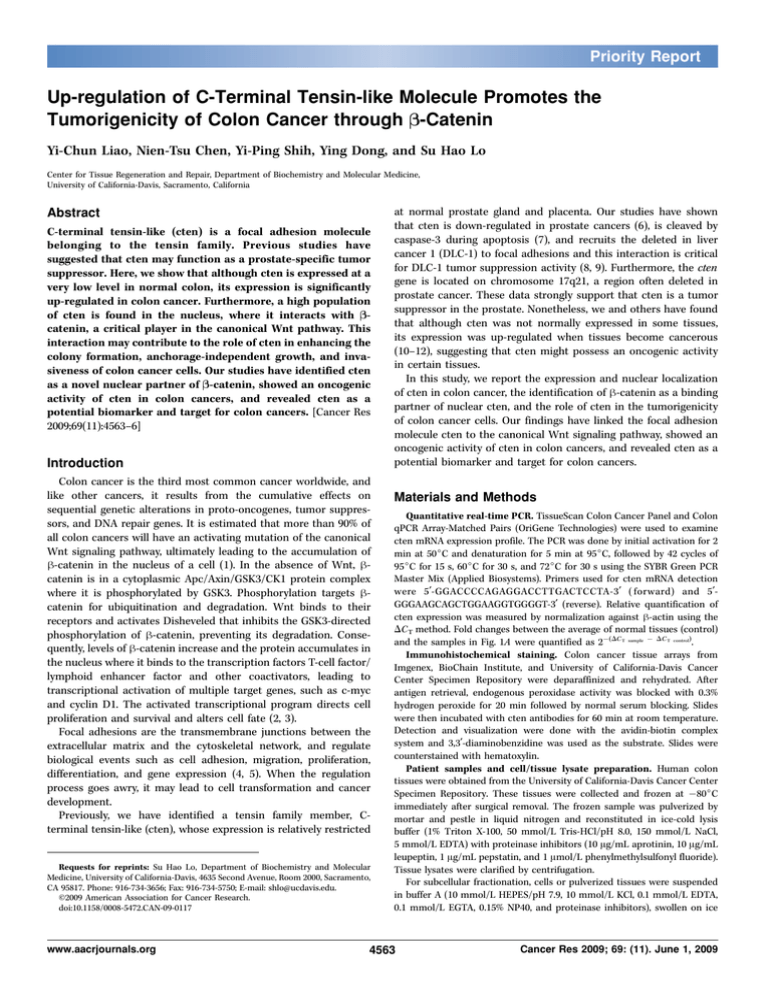
Priority Report Up-regulation of C-Terminal Tensin-like Molecule Promotes the Tumorigenicity of Colon Cancer through B-Catenin Yi-Chun Liao, Nien-Tsu Chen, Yi-Ping Shih, Ying Dong, and Su Hao Lo Center for Tissue Regeneration and Repair, Department of Biochemistry and Molecular Medicine, University of California-Davis, Sacramento, California Abstract C-terminal tensin-like (cten) is a focal adhesion molecule belonging to the tensin family. Previous studies have suggested that cten may function as a prostate-specific tumor suppressor. Here, we show that although cten is expressed at a very low level in normal colon, its expression is significantly up-regulated in colon cancer. Furthermore, a high population of cten is found in the nucleus, where it interacts with Bcatenin, a critical player in the canonical Wnt pathway. This interaction may contribute to the role of cten in enhancing the colony formation, anchorage-independent growth, and invasiveness of colon cancer cells. Our studies have identified cten as a novel nuclear partner of B-catenin, showed an oncogenic activity of cten in colon cancers, and revealed cten as a potential biomarker and target for colon cancers. [Cancer Res 2009;69(11):4563–6] Introduction Colon cancer is the third most common cancer worldwide, and like other cancers, it results from the cumulative effects on sequential genetic alterations in proto-oncogenes, tumor suppressors, and DNA repair genes. It is estimated that more than 90% of all colon cancers will have an activating mutation of the canonical Wnt signaling pathway, ultimately leading to the accumulation of h-catenin in the nucleus of a cell (1). In the absence of Wnt, hcatenin is in a cytoplasmic Apc/Axin/GSK3/CK1 protein complex where it is phosphorylated by GSK3. Phosphorylation targets hcatenin for ubiquitination and degradation. Wnt binds to their receptors and activates Disheveled that inhibits the GSK3-directed phosphorylation of h-catenin, preventing its degradation. Consequently, levels of h-catenin increase and the protein accumulates in the nucleus where it binds to the transcription factors T-cell factor/ lymphoid enhancer factor and other coactivators, leading to transcriptional activation of multiple target genes, such as c-myc and cyclin D1. The activated transcriptional program directs cell proliferation and survival and alters cell fate (2, 3). Focal adhesions are the transmembrane junctions between the extracellular matrix and the cytoskeletal network, and regulate biological events such as cell adhesion, migration, proliferation, differentiation, and gene expression (4, 5). When the regulation process goes awry, it may lead to cell transformation and cancer development. Previously, we have identified a tensin family member, Cterminal tensin-like (cten), whose expression is relatively restricted Requests for reprints: Su Hao Lo, Department of Biochemistry and Molecular Medicine, University of California-Davis, 4635 Second Avenue, Room 2000, Sacramento, CA 95817. Phone: 916-734-3656; Fax: 916-734-5750; E-mail: shlo@ucdavis.edu. I2009 American Association for Cancer Research. doi:10.1158/0008-5472.CAN-09-0117 www.aacrjournals.org at normal prostate gland and placenta. Our studies have shown that cten is down-regulated in prostate cancers (6), is cleaved by caspase-3 during apoptosis (7), and recruits the deleted in liver cancer 1 (DLC-1) to focal adhesions and this interaction is critical for DLC-1 tumor suppression activity (8, 9). Furthermore, the cten gene is located on chromosome 17q21, a region often deleted in prostate cancer. These data strongly support that cten is a tumor suppressor in the prostate. Nonetheless, we and others have found that although cten was not normally expressed in some tissues, its expression was up-regulated when tissues become cancerous (10–12), suggesting that cten might possess an oncogenic activity in certain tissues. In this study, we report the expression and nuclear localization of cten in colon cancer, the identification of h-catenin as a binding partner of nuclear cten, and the role of cten in the tumorigenicity of colon cancer cells. Our findings have linked the focal adhesion molecule cten to the canonical Wnt signaling pathway, showed an oncogenic activity of cten in colon cancers, and revealed cten as a potential biomarker and target for colon cancers. Materials and Methods Quantitative real-time PCR. TissueScan Colon Cancer Panel and Colon qPCR Array-Matched Pairs (OriGene Technologies) were used to examine cten mRNA expression profile. The PCR was done by initial activation for 2 min at 50jC and denaturation for 5 min at 95jC, followed by 42 cycles of 95jC for 15 s, 60jC for 30 s, and 72jC for 30 s using the SYBR Green PCR Master Mix (Applied Biosystems). Primers used for cten mRNA detection were 5¶-GGACCCCAGAGGACCTTGACTCCTA-3¶ ( forward) and 5¶GGGAAGCAGCTGGAAGGTGGGGT-3¶ (reverse). Relative quantification of cten expression was measured by normalization against h-actin using the DC T method. Fold changes between the average of normal tissues (control) and the samples in Fig. 1A were quantified as 2 (DC T sample DC T control). Immunohistochemical staining. Colon cancer tissue arrays from Imgenex, BioChain Institute, and University of California-Davis Cancer Center Specimen Repository were deparaffinized and rehydrated. After antigen retrieval, endogenous peroxidase activity was blocked with 0.3% hydrogen peroxide for 20 min followed by normal serum blocking. Slides were then incubated with cten antibodies for 60 min at room temperature. Detection and visualization were done with the avidin-biotin complex system and 3,3¶-diaminobenzidine was used as the substrate. Slides were counterstained with hematoxylin. Patient samples and cell/tissue lysate preparation. Human colon tissues were obtained from the University of California-Davis Cancer Center Specimen Repository. These tissues were collected and frozen at 80jC immediately after surgical removal. The frozen sample was pulverized by mortar and pestle in liquid nitrogen and reconstituted in ice-cold lysis buffer (1% Triton X-100, 50 mmol/L Tris-HCl/pH 8.0, 150 mmol/L NaCl, 5 mmol/L EDTA) with proteinase inhibitors (10 Ag/mL aprotinin, 10 Ag/mL leupeptin, 1 Ag/mL pepstatin, and 1 Amol/L phenylmethylsulfonyl fluoride). Tissue lysates were clarified by centrifugation. For subcellular fractionation, cells or pulverized tissues were suspended in buffer A (10 mmol/L HEPES/pH 7.9, 10 mmol/L KCl, 0.1 mmol/L EDTA, 0.1 mmol/L EGTA, 0.15% NP40, and proteinase inhibitors), swollen on ice 4563 Cancer Res 2009; 69: (11). June 1, 2009 Cancer Research Figure 1. Cten expression and distribution in colon cancer patients. A, quantitative PCR analysis of cten transcripts in 5 normal colon and 43 cancer samples from four disease stages. Number labels in X-axis indicate different patients. B, ratio of cten expression in colon cancer/adjacent normal tissues in 24 matched pairs of patient samples. C, representative cten immunohistochemical staining in colon cancer and normal specimens. Boxed area in colon cancer sample (left ) is enlarged and shown in the middle. Arrows, presence of cten staining in nuclei. Bar, 100 Am. D, six matched pairs of colon cancer (T ) and adjacent normal tissue (N ) lysates (30 Ag each) from patients with different percentage of tumor lesion were immunoblotted (IB ) with indicated antibodies. Cten degradation was observed in some samples. E, the cytoplasmic (Cy) and nuclear (Nu ) fractions (40 Ag each) from the fifth colon cancer patient sample shown in D were immunoblotted with indicated antibodies. a-Tubulin and poly(ADP-ribose) polymerase (PARP ) antibodies were used to confirm no cross-contamination between two fractions. for 10 min, and then centrifuged at 12,000 g for 30 s at 4jC. Supernatant was collected as cytoplasmic extract. The pellet was washed, resuspended in buffer B (20 mmol/L HEPES/pH 7.9, 400 mmol/L NaCl, 1 mmol/L EDTA, 1 mmol/L EGTA, 0.5% NP40, and proteinase inhibitors), and rocked for 15 min at 4jC. The supernatant after centrifugation was used as nuclear extract. Colony formation assay. Colony formation assay was done as previously described (9). The siRNA targeting APC (Dharmacon), h-catenin (Santa Cruz Biotechnology), or cten (Invitrogen) or a nonspecific siRNA (Santa Cruz Biotechnology) was transfected together with pEGFP ( for drug selection) into SW480 using Lipofectamine 2000. Soft agar assay. Five thousand SW480 cells were resuspended in medium containing 0.3% low-melting agarose 24 h after transfection of indicated siRNA and then layered on top of a solidified 0.5% base agarose. After 3-wk incubation, the colonies were stained with crystal violet. Invasion assay. SW480 cells transfected with h-catenin siRNA, cten siRNA, or a nonspecific siRNA were seeded on 8.0-Am-pore Transwells (Corning) previously covered with Matrigel. DMEM with 10% serum was used as a chemoattractant in the lower chamber. After 40-h incubation, the invading cells were fixed in formaldehyde and stained with crystal violet. and protein levels of cten were analyzed. Cten transcripts were upregulated (>4-fold) in 91% (39 of 43; or >10-fold in 74%) of colon cancers by quantitative PCR analysis (Fig. 1A). Additionally, >4-fold increases of cten transcripts were detected in 83% (20 of 24) of the cancerous samples in comparison with those in the adjacent normal counterparts in the same individual (Fig. 1B). At the protein levels, cten immunohistochemical staining in normal colon tissues was very weak and was significantly enhanced in 76% (90 of 118) of cancer samples (Fig. 1C). Interestingly, we often observed nuclear, in addition to cytoplasmic, staining of cten in cancer samples. We further examined cten protein levels in matched cancer and adjacent normal colon tissue pairs by immunoblotting (Fig. 1D). Cten protein was only detected in the cancer samples and the levels matched very well with the percentage of tumor lesion in each sample. To confirm cten nuclear staining, we have isolated cytoplasmic and nuclear fractions from colon cancer tissue for immunoblotting analysis and detected cten proteins in both Results Enhanced cten expression and nucleus localization in colon cancers. To examine cten expression in colon cancers, the mRNA Figure 2. Cten expression in various cell lines and its subcellular distribution. A, total cell lysates (20 Ag) from indicated cell lines were immunoblotted with indicated antibodies. B, cytoplasmic (Cy ) and nuclear (Nu ) fractions of SW480 and HCT116 cell lines (30 Ag) were immunoblotted with indicated antibodies. Cten degradation was observed in some samples. Cancer Res 2009; 69: (11). June 1, 2009 Figure 3. Cten associates with h-catenin in the nucleus. A, total cell lysates (1.5 mg) of SW480 or HCT116 were coimmunoprecipitated (CoIP ) with anti-cten antibody and then immunoblotted by h-catenin antibody. B, cytoplasmic (2.2 mg) and nuclear proteins (240 Ag) from SW480 or cytoplasmic (3.7 mg) and nuclear proteins (680 Ag) from HCT116 were coimmunoprecipitated with anti-cten antibody and then immunoblotted with h-catenin antibody. Note that the lower h-catenin band in HCT116 Nu might represent degradation products. 4564 www.aacrjournals.org Cten in Colon Cancer compartments (Fig. 1E). In human cell lines, cten was expressed at higher levels in SW480, SW620, and HT29 colon cancer cell lines and MLC-SV40 nonmalignant prostate epithelial cells, whereas lower levels were found in HCT116 and LoVo cells (Fig. 2A). In contrast, cten was not detected in the FHC human normal colon epithelial cells. Cten subcellular localization was further analyzed in SW480 and HCT116 cells. Again, cten was present in nuclear and cytoplasmic fractions in both cell lines (Fig. 2B). These studies have shown that (a) cten is expressed at a very low level in normal colon tissues and cells; (b) cten is overexpressed at mRNA and protein levels in colon cancers; and (c) a population of cten is present in the nuclei of colon cancer cells. Cten interacts with B-catenin in the nucleus. Because Wnt signaling is highly involved in colon cancers, we speculated that cten might participate in the h-catenin canonical pathway and tested whether cten interacted with h-catenin. Indeed, h-catenin was co- immunoprecipitated with cten (Fig. 3A). Because both cten and hcatenin travel between the cytoplasm and nucleus, we asked where the interaction took place by separating nuclear and cytoplasmic fractions for coimmunoprecipitation assay. Interestingly, even more h-catenin and cten proteins were found in the cytoplasm; h-catenin/ cten interaction was only detected in the nucleus (Fig. 3B). Cten modulates the colony formation, anchorage-independent growth, and invasiveness of colon cancer cells through the B-catenin–dependent pathway. To establish the function of cten in tumorigenicity of colon cancer cells, we have carried out colony formation, soft agar, and invasion assays. For colony formation, we first manipulated cten expression levels in two cell lines by suppression in cten high expressing SW480 cells or enhancement in cten low expressing HCT116 cells. As shown in Fig. 4A and B, suppression of cten expression reduced the colony formation activity of SW480, whereas overexpression of cten in HCT116 further enhanced its colony Figure 4. Cten modulates the tumorigenicity of colon cancer cells. A, the histogram shows the colony formation efficiency of SW480 transfected with siRNAs targeting APC, h-catenin, or cten. Columns, mean (n = 3); bars, SD. *, P < 0.05, compared with group 8 (Student’s t test). B, histogram showing the colony formation efficiency of HCT116 transfected with pEGFP or pEGFP-cten. C, soft agar assay of SW480 transfected with h-catenin or/and cten siRNA. A representative panel is shown for each transfection. D, the histogram shows the quantification of cell invasion. *, P < 0.05, compared with control. Bar, 200 Am. www.aacrjournals.org 4565 Cancer Res 2009; 69: (11). June 1, 2009 Cancer Research formation activity. We next asked whether the tumor-promoting effect of cten is associated with the canonical Wnt pathway. Because APC is a scaffolding protein in part of a complex modulated by Wnt signaling and APC negatively regulates the activation of h-catenin, colony formation assays were carried out by suppressing endogenous truncated APC (1-1337) and wild-type h-catenin alone or together with cten in SW480 cells. Although knockdown of truncated APC showed a mild effect, it is not statistically significant (Fig. 4A). Nonetheless, cten knockdown significantly reduced the number of colonies to a similar level with that of h-catenin knockdown. Similarly, treatment of cten siRNA remarkably suppressed the anchorageindependent growth (Fig. 4C) and profoundly inhibited cell invasion (Fig. 4D) to a level comparable to those in h-catenin–depleted SW480 cells. However, no additive or synergistic effect was detected when both cten and h-catenin expressions were suppressed simultaneously. Taken together, these results suggested that cten regulates the tumorigenicity of colon cancer cells through the h-catenin–dependent pathway. Discussion In this study, we have detected a consistent up-regulation of cten in all stages of colon cancer (Fig. 1) and its effect on colony formation, anchorage-independent growth, and cancer cell invasion (Fig. 4), indicating that cten overexpression is associated with colon tumors at very early stage and is likely to be involved in tumor formation as well as progression. Recently, Sabates-Bellver and colleagues (13) reported the transcriptome profile of human colorectal adenomas by analysis of microarray data from 32 adenoma/normal mucosa tissue pairs. In agreement with our finding, they had detected a 4.8-fold increase of cten mRNA in adenomas, which were the precancerous lesions in the colon. This, together with its very low basal expression level in normal colon tissues, makes cten a very attractive biomarker for colon cancer. A main role of cten at focal adhesions is to regulate the integrinactin cytoskeleton organization and focal adhesion complex for cell adhesion/migration events. This role is accomplished, at least in part, by the tensin-cten expression switch (12) and by recruiting DLC-1 to focal adhesion sites. Focal adhesion localization of DLC-1 References 1. Giles RH, van Es JH, Clevers H. Caught up in a Wnt storm: Wnt signaling in cancer. Biochem Biophys Acta 2003;1653:1–24. 2. Clevers H. Wnt/h-catenin signaling in development and disease. Cell 2006;127:469–80. 3. Moon RT, Kohn AD, De Ferrari GV, Kaykas A. WNT and h-catenin signalling: diseases and therapies. Nat Rev Genet 2004;5:691–701. 4. Hynes RO. Integrins: bidirectional, allosteric signaling machines. Cell 2002;110:673–87. 5. Schwartz MA, Schaller MD, Ginsberg MH. Integrins: emerging paradigms of signal transduction. Annu Rev Cell Dev Biol 1995;11:549–99. 6. Lo SH, Lo TB. Cten, a COOH-terminal tensin-like protein with prostate restricted expression, is down-regulated in prostate cancer. Cancer Res 2002;62:4217–21. 7. Lo SS, Lo SH, Lo SH. Cleavage of cten by caspase-3 during apoptosis. Oncogene 2005;24:4311–4. 8. Liao YC, Lo SH. Deleted in liver cancer-1 (DLC-1): a Cancer Res 2009; 69: (11). June 1, 2009 is essential for DLC-1 tumor suppression activity (8, 14). This also suggests a role of cten in preventing cell transformation. However, this function of cten probably is not relevant in the colon because cten is not expressed in normal colon cells and DLC-1 is often absent or down-regulated in colon cancers (15). Another two novel findings in this report are that cten is a nuclear protein and interacts with nuclear h-catenin, linking a focal adhesion molecule to the canonical Wnt pathway. It is known that a group of focal adhesion molecules, including Abl family, zyxin family, paxillin family, and cysteine-rich protein family, is able to travel to the nucleus (16). Some of these molecules bind to transcription factors and function as coregulators and others may serves as a chaperone that directs the targeting of specific mRNAs to nascent focal adhesions for localized protein translation. For example, LPP interacts with PEA3 transcription factor and transactivates PEA3-dependent gene expression (17). TRIP6 is recruited to activator protein-1 and nuclear factor-nB promoters, where it serves as a coactivator (18). Paxillin binds to poly(A)-binding protein-1 and promotes the export of poly(A)-binding protein1–bound mRNAs into cytoplasm and targets the ribonucleoprotein complex to the leading edge of a migrating cell (19). Cten has joined this list of nucleus/focal adhesion molecules because it interacts with nuclear h-catenin. Although many functions of cten rely on the presence of h-catenin (Fig. 4), the role of cten/h-catenin interaction remains to be investigated. It is possible that cten may be involved in the nuclear retention of h-catenin or regulation of h-catenin/ T-cell factor transcriptional activity. Disclosure of Potential Conflicts of Interest No potential conflicts of interest were disclosed. Acknowledgments Received 1/12/09; revised 3/31/09; accepted 4/22/09. Grant support: NIH grant CA102537 (S.H. Lo). The costs of publication of this article were defrayed in part by the payment of page charges. This article must therefore be hereby marked advertisement in accordance with 18 U.S.C. Section 1734 solely to indicate this fact. tumor suppressor not just for liver. Int J Biochem Cell Biol 2007;40:843–7. 9. Liao YC, Si L, Devere White RW, Lo SH. The phosphotyrosine-independent interaction of DLC-1 and the SH2 domain of cten regulates focal adhesion localization and growth suppression activity of DLC-1. J Cell Biol 2007;176:43–9. 10. Sasaki H, Moriyama S, Mizuno K, et al. Cten mRNA expression was correlated with tumor progression in lung cancers. Lung Cancer 2003;40:151–5. 11. Sasaki H, Yukiue H, Kobayashi Y, Fukai I, Fujii Y. Cten mRNA expression is correlated with tumor progression in thymoma. Tumour Biol 2003;24:271–4. 12. Katz M, Amit I, Citri A, et al. A reciprocal tensin-3cten switch mediates EGF-driven mammary cell migration. Nat Cell Biol 2007;9:961–9. 13. Sabates-Bellver J, Van der Flier LG, de Palo M, et al. Transcriptome profile of human colorectal adenomas. Mol Cancer Res 2007;5:1263–75. 14. Qian X, Li G, Asmussen HK, et al. Oncogenic inhibition by a deleted in liver cancer gene requires 4566 cooperation between tensin binding and Rho-specific GTPase-activating protein activities. Proc Natl Acad Sci U S A 2007;104:9012–7. 15. Ullmannova V, Popescu NC. Expression profile of the tumor suppressor genes DLC-1 and DLC-2 in solid tumors. Int J Oncol 2006;29:1127–32. 16. Hervy M, Hoffman L, Beckerle MC. From the membrane to the nucleus and back again: bifunctional focal adhesion proteins. Curr Opin Cell Biol 2006;18:524–32. 17. Guo B, Sallis RE, Greenall A, et al. The LIM domain protein LPP is a coactivator for the ETS domain transcription factor PEA3. Mol Cell Biol 2006;26:4529–38. 18. Kassel O, Schneider S, Heilbock C, Litfin M, Gottlicher M, Herrlich P. A nuclear isoform of the focal adhesion LIM-domain protein Trip6 integrates activating and repressing signals at AP-1- and NF-nB-regulated promoters. Genes Dev 2004;18:2518–28. 19. Woods AJ, Kantidakis T, Sabe H, Critchley DR, Norman JC. Interaction of paxillin with poly(A)-binding protein 1 and its role in focal adhesion turnover and cell migration. Mol Cell Biol 2005;25:3763–3773. www.aacrjournals.org
